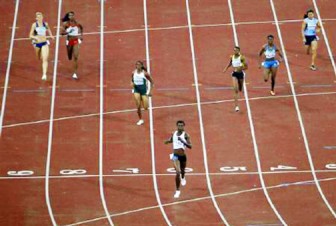Athletics
Despite a few glitches, 2010 was a noteworthy year for athletics and measures implemented under the new Athletics Association of Guyana (AAG) president Colin Boyce will ensure that athletes are afforded better opportunities to develop their talents in 2011.
The year opened and closed on two high points beginning on the international scene with Aliann Pompey’s strides to the finals of the women’s 400m at the 13th International Association of Athletics Federation (IAAF) World Indoor Championships in March and winding down with the start of construction on Guyana’s first ever synthetic track in December.
Pompey proved for yet another year that she is one of Guyana’s most valuable athletes. At the Championships, she became the first Guyanese to reach the finals at a world track competition, a feat that was not overshadowed despite her fifth place finish in a time of 52.75 seconds.

But Guyana’s peak performance for the year was no doubt Pompey’s women’s 400m silver medal win at the internationally attended Commonwealth Games (CWG) held during October in India. Pompey’s medal was Guyana’s only one at the Games, complementing the gold medal she won when the CWG was held in 2002. She remains the only Guyanese to earn two medals at the event. Pompey’s success was coupled with Cleveland Forde’s record-breaking performance at the event, where he established Guyana’s newest men’s 1500m record at 3:44.23.
Preceding this Forde and Marian Burnett both won got bronze medals in the Central American and the Caribbean (CAC) Games men’s 5000m and women’s 800m, respectively. Pompey won silver in the women’s 400m at the Games which were held in Puerto Rico from July 18 – August 1. The athletics contingent also included Adam Harris, Devon Bond, Lee Powell, and Gordon McKenzie.
An overseas-based sprinter, Harris was a repeat feature at the CWG where he was also joined by fellow overseas-based sprinter Jeremy Bascom. Both performed in the men’s 100m and 200m at the event but the locally-based athletes clocked better times at home on the grass track. Bascom’s selection for the CWG was also a contentious issue for the AAG. He was said to have clocked 10 seconds in the 100m, a feat that was reportedly recorded at a New Jersey meet but remains unsanctioned by the IAAF and therefore rendered null and void. His pedestrian performance at the Games also suggested that the AAG might have had better chances pulling more athletes from the local corps.
Another source of embarrassment for Guyana came when Burnett spoke out after CAC Games about the poor treatment meted out to Guyanese athletes by the local agencies. Burnett had fallen ill during the Games and was appalled by the indifference shown by the local organisers. This issue was regurgitated later in the year when it was revealed that long distance queen Alika Morgan had also performed at a number of events in poor health and that no attention had been paid to her until it was time for her to perform at meets.
The AAG president’s subsequent assertion that it is responsible for athletics and not the athletes left little doubt in the public’s view that the athletes are given very little consideration. Nevertheless, it is expected that these and other issues will be addressed as the AAG has propounded a plan that entails compiling and monitoring the country’s elite athletes during the new year.
Among the junior athletes Chavez Ageday was Guyana’s showpiece for the year followed closely by promising middle distance athlete Jevina Straker. Ageday, a sprinter, used his impromptu selection to represent Guyana at the South American Under-23 Games in March to shine. He made it to the finals in both the 100m and 200m events placing seventh in both and clocking times of 10.82 and 22.07 seconds respectively. The Games were held in conjunction with the South American Games in Columbia.
Both Ageday and Straker were part of the seven-person athletics team that travelled to the Cayman Islands for the Junior CARIFTA Games in April. Straker stole the spotlight with her gold medal win in the 1500m. However, these games also attracted controversy when it was learnt that Cortez Fraser was left behind in Guyana, a situation that did not sit too well with the youth’s father, who vented his displeasure in the media.
Another low point for the sport came when for the first time Guyana lost the track and field division of the IGG held in French Guiana in March. Subsequent reports attributed this to the low strength of the team which lacked the presence of several of its key athletes, including Ageday and Straker.
Back on the international scene, in July, Ageday was Guyana’s representative at the (IAAF) World Junior Championships in Canada, and then a repeat selection for the athletics division at inaugural Youth Olympic Games held during August in Singapore, alongside Straker.
Locally apart from the synthetic track, there were a number of developments including the implementation of the first ever inter-club meets where monetary prizes were up for grabs. A venture aimed at putting clubs in a better financial position to assist their athletes. This included the National Under-23 Games which is aimed at developing athletes’ talents. The first leg of the IAAF South American 10K Classic was also held. Labelled a “signature event” by Minister of Sports Dr Frank Anthony, this was a commendable closer to local track and field events.
Forde won the first two legs of the 10K and a second place in the ill-organized third leg in Panama which was in good showing for Guyana. And despite her illness, which stifled some of her performances, Morgan still managed a year’s worth of credible performances. There also a number of notable performances by Jevina Sampson, Ashley Tasher and Nathaniel Giddings.





